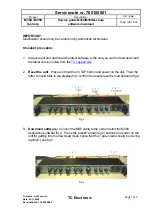
NEO-D9S and ZED-F9 configuration
UBX- 22008160 - R02
Introduction
Page 4 of 17
C1-Public
1
Introduction
The ZED-F9 high precision modules have integrated multiband PPP-RTK technology for centimeter-
level accuracy using SPARTN [8] State Space Representation (SSR) type of correction.
SSR services rely on a GNSS reference station network to model key errors (such as satellite or
atmospheric errors) over large geographical regions and provide corrections to the rover via broadcast
link such as internet or satellite L-band, all receivers receive the same data over a large area.
☞
Check if the ZED-F9 product that you are using supports the SPARTN L-band stream formatted
as UBX-RXM-PMP messages, and the related configurations.
Figure 1 represents how NEO-D9S and ZED-F9 work together:
Figure 1: NEO-D9S and ZED-F9 scenario
NEO-D9S is a satellite data receiver for L-band correction broadcasts, which can be configured to
work with a variety of correction services. This document provides instructions on how to configure
NEO-D9S for this purpose and provides configuration examples for the PointPerfect service, SPARTN
L-band correction, and ZED-F9 receivers. Figure 2 represents the NEO-D9S and ZED-F9 connection:
Figure 2: NEO-D9S and ZED-F9 connection
The NEO-D9S and ZED-F9 receivers follow the u-blox configuration concept. The UBX-CFG-VALSET,
UBX-CFG-VALGET, and UBX-CFG-VALDEL messages can be used to configure the SPARTN L-band
correction data reception. See the D9 PMP 1.04 Interface description [4] and the F9 HPG 1.32
Interface description [5] for further details.
For the correction data, NEO-D9S and ZED-F9 can be connected via their respective UART2
interfaces, as shown in Figure 2. The UART2 connection is commonly used and recommended for
customer designs, while The UART1 can be used as the main host interface for configuration,



































